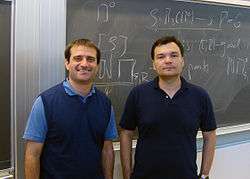Jeremy Kahn
Jeremy Adam Kahn (born October 26, 1969) is an American mathematician. He works on hyperbolic geometry, Riemann surfaces and complex dynamics.
Jeremy A. Kahn | |
|---|---|
 Jeremy Kahn (left) and Vladimir Markovic | |
| Born | October 26, 1969 |
| Nationality | American |
| Alma mater | Harvard University University of California, Berkeley |
| Scientific career | |
| Fields | Mathematics |
| Institutions | California Institute of Technology Stony Brook University Brown University |
| Doctoral advisor | Curtis McMullen |
Education
Kahn grew up in New York City and attended Hunter College High School. He was a child prodigy who mastered quadratic equations at the age of 7, at the age of 8 designed an equation identical to the one Carl Gauss designed at the age of 9, and proved the Pythagorean Theorem at the age of 10.[1] Kahn was part of the Johns Hopkins University Study of Mathematically Precocious Youth longitudinal cohort. At the age of 11, he scored a 780 out of a possible 800 on the math portion of the SAT-I exam.[1] At the age of 13, he broke the record for making the United States team for the International Mathematical Olympiad [2] He participated four times, winning silver medals in 1983 and 1984, and gold medals in 1985 and 1986.[3]
On the basis of his success in the Putnam competition, he became a Putnam Fellow in 1988.[4] He received a bachelor's degree in mathematics at Harvard University, then received his Ph.D. from the University of California, Berkeley in 1995 under Curtis McMullen with the thesis Holomorphic removability of quadratic polynomial Julia sets.[5]
Career
Kahn was Assistant Professor at the California Institute of Technology from 1995 to 1998 and was later a postdoc at the University of Toronto. After that, he worked for the investment firm Highbridge Capital Management as an analyst in financial mathematics. He was a postdoc and later assistant professor at the Stony Brook University. He is currently a professor of mathematics at Brown University.[6]
In 2012, Kahn and Vladimir Markovic received the Clay Research Award for their research on hyperbolic geometry, specifically, for their result on immersions into a closed hyperbolic 3-manifold (proof of the surface subgroup conjecture)[7] and for their proof of the Ehrenpreis conjecture.[8]
In 2014 he was an invited speaker at the International Congress of Mathematicians in Seoul and gave a talk called "The Surface Subgroup and the Ehrenpreis Conjectures".
Selected publications
- Kahn, Jeremy; Markovic, Vladimir (2012). "Immersing almost geodesic surfaces in a closed hyperbolic three manifold". Annals of Mathematics. 2. 175 (3): 1127–1190. arXiv:0910.5501. doi:10.4007/annals.2012.175.3.4. MR 2912704.
- Avila, Artur; Kahn, Jeremy; Lyubich, Mikhail; Shen, Weixiao (2009). "Combinatorial rigidity for unicritical polynomials". Annals of Mathematics. 170 (2): 783–797. arXiv:math/0507240. doi:10.4007/annals.2009.170.783. JSTOR 25662159. MR 2552107.
References
- Marquand, Robert (July 12, 1985). "Growing up gifted: three-time math Olympian Jeremy Kahn". The Christian Science Monitor.
- https://www.gwern.net/docs/iq/smpy/1987-stanley.pdf
- https://www.imo-official.org/participant_r.aspx?id=1411
- https://www.jstor.org/stable/2324716?seq=1#page_scan_tab_contents
- Jeremy Kahn at the Mathematics Genealogy Project
- http://directory.brown.edu/uuid/0489ffd0-c072-523e-f868-d9830b179f36
- Kahn, J.; Markovic, V. (2009). "Immersing almost geodesic surfaces in a closed hyperbolic 3-manifold". arXiv:0910.5501. Preprint in 2009; published in Annals of Mathematics in 2011
- Kahn, J.; Markovic, V. "The good pants homology and a proof of the Ehrenpreis conjecture". arXiv:1101.1330.
External links
- "Homepage at Brown University". (With some online preprints.)